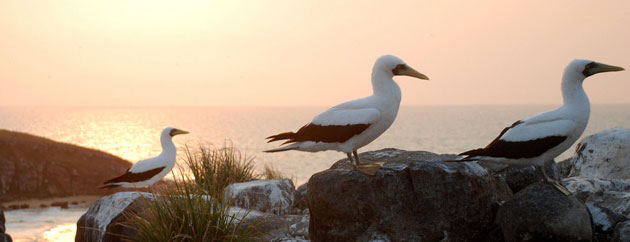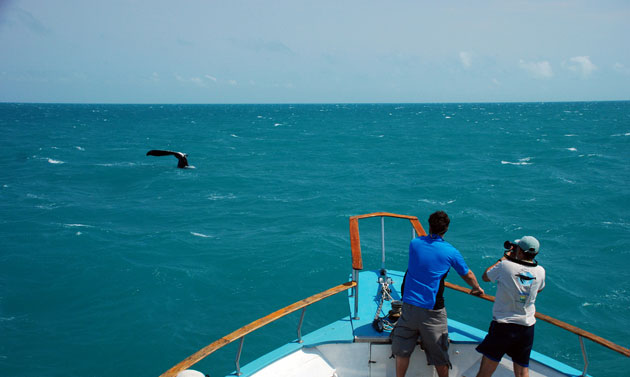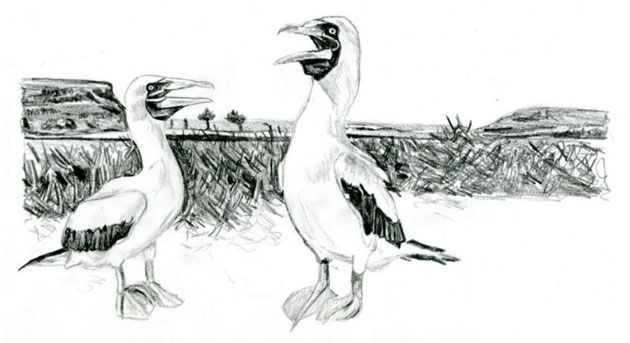
A sight to behold: Abrolhos Marine National Park
22 September, 2011In the North-East of Brazil the state of Bahia is found, a vibrant and colourful region, glowing with a rich mixture of European and African influences. Baroque churches, Candomblé ceremonies, the unmistakable twang of the berimbau commanding a Capoeira roda, and the birthplace of Jorge Amado and apparently of chocolate. But the riches of Bahia are not only restricted to the cobblestone streets of places such as Olinda, or the dream-like beaches of its coconut-laden coast. There is also much to be explored away from the land. Jorge Amado may have written of a “Mar Morto”, but the sea surrounding Bahia is anything but dead.
In the waters off the southern coast of Bahia is found what is thought to be the most diverse concentration of marine life in the South Atlantic, including complex and unique ecosystems. Vibrant corals and extensive mangroves shelter hundreds of different species, many of which are found nowhere else on the planet. Within these waters resides the Abrolhos Marine National Park, an archipelago consisting of five small volcanic islands: Guarita, Santa Bárbara, Redonda, Sueste and Siriba. Abrolhos is the most extensive marine park of Brazil, being home to the largest and richest coral reefs in the South Atlantic. 270 species of reef and shore fish can be found, along with marine turtles and mammals such as dolphins.
The name Abrolhos comes from the phrase “abre os olhos”, which in Portuguese means “keep your eyes peeled”. This expression is credited to Américo Vespucio, who visited the archipelago in 1503. Aware of the perils that the coral reefs represented to ships, he was prudent enough to leave a warning for future navigators. Fortunately, Abrolho’s crystalline waters permit the observation of the fauna and flora found below the surface. During the dry season, from May to September, visibility extends to 20 meters, and with a water temperature of approximately 24˚C all year round, it is not surprising that Abrolhos is a popular destination for divers. A vessel that sank some time after the days of Vespucio, the Italian cargo ship “Rosalina”, presents a particular attraction.
But for those who like to keep their feet dry, Abrolhos is not a place to be ignored; the park also offers activities that can be enjoyed from the safety of a boat. During July to November, when winter arrives at the Antarctic, Yubarta or Humpback whales can be found in the waters around Abrolhos, having travelled north in search of warmer seas. Individual whales have been found returning to these waters for up to 16 years. And it is in these warm Brazilian waters that the whales mate and give birth, and the Abrolhos region is the most important breeding ground for this species in the Southwestern Atlantic Ocean. These magnificent animals, weighing up to 40 tons, give birth to a calf approximately 3 meters long that will drink some 200 litres of milk a day.

Whale hunting was prohibited in Brazil in 1987, and whale watching now represents an important source of income for the Abrolhos region. According to the IUCN, Humpback whale populations are increasing, and the species is not one at risk of extinction. But whilst whale watching may provide an economic incentive for the preservation of these animals and generate environmental education, this activity is being monitored, to ensure that disruption does not occur within an important reproductive zone. Only authorised boats are in fact allowed into the Abrolhos region, and the archipelago can only be reached by boat. Lying 67 km off the coast of Bahia, a journey of two and a half hours on an ocean cruiser, or six to seven hours by sail-boat, can be made from Caravelas, named after the Portuguese “caravel” sailing ships of the 15th century.
One or two-day long excursions to the park can be made, with longer stays made possible by renting a sail-boat or catamaran. On only one of the archipelago’s islands, Siriba, are tourists allowed to go ashore, and only when accompanied by a guide from IBAMA, the Brazilian environment agency. Visitors are not allowed to stay overnight on the island, and so any sleeping must be done at sea. Tourism is now the primary source of income in the region, and its regulation is crucial to avoid any negative impacts that it might have. Abrolhos not only harbours important wildlife within its waters, but also on its islands. These islands provide important nesting grounds for a number of seabirds, such as boobies (illustrated below) and frigate birds. Colonies of the masked booby (Sula dactylatra), for example, can be seen on Siriba. These birds depend on healthy fish populations within the park.

The park’s coral reefs provide an ideal environment for the growth and reproduction of many marine species, including commercially important fish. Many of these fish spend their entire lives within a few kilometres of the shore, providing the main source of protein for 80 percent of local communities. Some 20,000 fishermen make their living within the Abrolhos region. But despite its social, economic and environmental importance, the long-term protection of the park still faces huge threats. Illegal and over-fishing, shrimp farming, exploitation of oil and natural gas near protected areas and sedimentation from coastal deforestation all pose threats. With only one patrol boat to cover the park’s 88,250 hectares, protecting the area against illegal fishing, for example, is not an easy task.
Since Abrolhos was established as a park in 1983, further measures have been taken to help ensure its protection. In 2002 the Abrolhos region was declared an area of Extreme Biological Importance by the Brazilian Ministry of Environment, and on World Wetlands Day in 2010, the park was designated a Ramsar Site, joining the list of Wetlands of International Importance. The Abrolhos Marine Protected Area network has also been augmented by the formation of Extractive Reserves. In 2000, for example, the Corumbau Extractive Reserve was set up, composed of no-take zones and areas that allow fishing. As fish numbers increase in the no-take zones, they then spill over into the regions where fishing is permitted. Since 2000, an increase in fish abundance of up to 300 per cent has been found for some commercially important species.
In 2010, the then-Brazilian President Luiz Inácio Lula da Silva visited Caravelas to declare the establishment of the Cassurubá Extractive Reserve, a sustainable-use protected area of 100,687 hectares. Species found within the reserve include crabs such as the swamp ghost crab (Ucides cordatus), and various molluscs and crustaceans, all of which will be sustainably harvested. Marine species potentially threatened with extinction, such as the Atlantic seabob (Xiphopenaeus kroyeri) and Atlantic goliath grouper (Epinephelus itajara) can also be found. The reserve also contributes to the protection of the coastal environments of the Abrolhos Bank, where 95 percent of the area’s mangroves are found. Mangrove forests serve as nurseries for several ecologically and economically important species, as well as providing water filtration and buffering coastal areas against storms.
The Abrolhos region has attracted visitors since long before our time, and perhaps that too of Américo Vespucio. The region is home to some of the world’s most unique and threatened corals, and since this navigator left his warning, species found here have long since vanished from other areas. But not only is Abrolhos a region of incredible beauty, it is also the most important fishing region of Bahia state. Long-term protection of Abrolhos is vital for its continuation as a source of income, not only through fishing, but also through tourism. “Abre os olhos” is a particularly pertinent phrase. Perhaps the danger that we most need to beware of is less one of a treacherous seascape, but a more fragile one, that may be damaged in ways much more severe than that which could be inflicted to ship’s hull. Thanks to the continuing work of conservation organizations and local people, the seas surrounding Abrolhos will hopefully never be described as “Mar Morto”.
Words and illustration by Emily Brown. Photos courtest of Turismo Bahia!
Follow Sounds and Colours: Facebook / Twitter / Instagram / Mixcloud / Soundcloud / Bandcamp
Subscribe to the Sounds and Colours Newsletter for regular updates, news and competitions bringing the best of Latin American culture direct to your Inbox.

